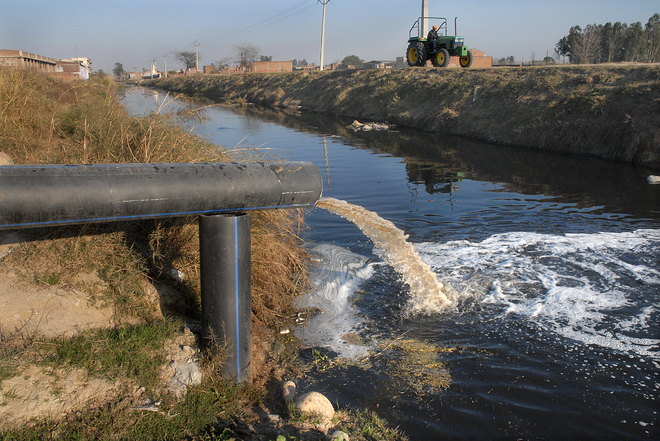
Effluents from leather complex treatment plant being discharged into the Kala Sanghian drain in Jalandhar. Tribune photo: Malkiat Singh
Aparna Banerji
Tribune News Service
Jalandhar, June 14
At Gazipur village, a man living along Kala Sanghian drain looks older than his age, but says he is 40. At Chamiara, a woman is yet to come to the terms after she lost her seven-year-old son to cancer last year. At Jahangir, some families living along Chitti Bein have sold their houses at throwaway prices.
There are several such stories of desperation, deprivation and death.
For the past many years, the government has been making umpteen promises to the residents of Doaba to clean drains and rivers. Several projects were conceived and initiated, but none completed till date.
The deadline for cleaning water works and starting sewage treatment plants (STPs) was extended last year for one more year. But till date, arsenic continues to flow in state drains even as hapless residents age early and fall prey to diseases.
Kala Sanghian drain
Considered the most polluted drain in the region, Kala Sanghian originates from Himmatpur village and ends at Malsian village where it joins East (Chitti) Bein, which further falls into the Sutlej. With 100 villages by its banks, it carries wastes from key industrial areas – leather complex, focal point and surgical complex.
At Chamiara, three cancer deaths have taken place in the past year. Villagers allege every night between 11 and 11.30, some pungent smell wafts through the air and the drain water rises as fresh chemicals are dumped into it.
Amolak Singh (40), who looks no less than a 70-year-old man and is often mistaken as his father’s brother, says: “We are worried about our next generation. Foul smell engulfing the village is a perennial problem. We have to light incense sticks, especially when we have visitors.”
At the leather complex, a 5 million litres per day (MLD) common effluent treatment plant (CETP) and a 50 MLD CETP at Basti Peerdaad are operational, but these still leave waste untreated. Another 1.5 MLD STP at the leather complex is non-functional.
Chitti Bein
With its origin from the Shivalik Hills, Chitti Bein starts getting polluted somewhere near Garhshankar. Its clean water has now turned toxic. There is a paper mill at Saila Khurd where the drain starts getting polluted. It then passes through Banga and Nawanshahr and by the time it reaches Phagwara, the pollution level reaches its limit.
Residents of Jahangir village in Nakodar have seen 12 cancer deaths in the past few years. In a recent incident, seven cattle left to graze along Chitti Bein died after drinking its water.
While a 20 MLD STP on the Phagwara Road has been set up to treat waste, it is not fully functional and much of the waste goes untreated. The only effective STP on its stretch is at the JCT mills, but unfortunately, its treated water is making its way back to the polluted drain.
Jamsher Drain
Jamsher is another highly polluted drain of the district. Waste from a dairy complex and focal point is dumped into it. A 100 million litres per day Pholariwal sewage treatment plant treats waste, but untreated filled water still finds its way into the drain.
The extent of pollution in the drain is such that residents can’t have borewells less than 250 ft deep (450 ft at some places). In Jalandhar, a 25 MLD STP at Jaitewali is currently under construction and the 10 MLD STP at the Bambianwali village is also yet to be started.
Kapurthala drains
The district primarily has Kali Bein, Riyasati Drain built by Maharaja Kapurthala to cater to the water needs of residents and Wadala drain. Despite being one of the famous eco success stories of Punjab, Kali Bein is still facing threat by waste from 22 villages. In both Wadala and Riaysati drains, some domestic waste is dumped regularly.
Earlier this year, many fish had died in the Kali Bein due to non-release of water from the Hydel Channel at Mukerian. Kapurthala drains, are treated by STPs at Begowal, Bholath, Kapurthala and Sultanpur Lodhi. The one at Dasuya, built by Sant Balbir Singh Seechewal as a temporary arrangement, is the only effective STP at the moment. A 5 MLD STP is also coming up at the same complex.
We are on job, says official
Manpreet Chatwal, Chairperson, Punjab Pollution Control Board (PPCB), said: “We are regularly reviewing the working of STPs and most are efficient. If any STP is getting lather-infested water or if there is any complaint regarding untreated water, we will probe the matter. The addition of modern STPs at Pholariwal will help us deal with Jalandhar’s sewage flow. The government has set a target of 100 per cent water treatment by 2017.”



























